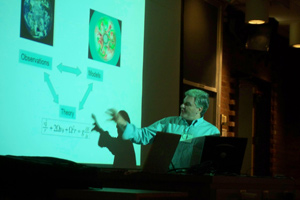Workshop: summary
Day 1: Meshing Science and Pedagogy
After a welcoming remark by the Department Chair Michael Foote, the program started with an introductory talk by John Marshall. He emphasized the combination of observations, experiments and theories as an effective teaching model. For example, a thermal wind lecture could include satellite data and simple model output to motivate a rotating tank experiment. Using a tank of water in solid body rotation with a cylinder of denser fluid released in the center, one can illustrate the combined effects of rotation and density variation, providing a more complete picture of a fluid dynamical concept and its real world implications.  One can go on to provide additional theory, introduce non-dimensional numbers and even perform some quantitative analysis. This framework is being tested by collaborators at a variety of institutions, for the Weather in a Tank project funded by NSF.
One can go on to provide additional theory, introduce non-dimensional numbers and even perform some quantitative analysis. This framework is being tested by collaborators at a variety of institutions, for the Weather in a Tank project funded by NSF.
Ruby Krishnamurti introduced a number of simple laboratory experiments to illustrate the effects of rotation and buoyancy. They included Taylor columns visualized using dye wires at various depths in a tank; buoyancy driven flows generated by heating from below, cooling from above, juxtaposing salty and fresh water, or bouncing bottles of air suspended in a fluid which has decreasing temperature with height; double diffusion in water with salt and sugar as the fast and slow diffusers, providing a transition from linear salt fingers to layered convection. A similar experiment with heat and salt illustrates the lateral mixing between subtropics and high latitude water masses in the ocean, a possible mechanism for generating potential energy necessary to sustain overturning. In all experiments visualization proves important (e.g. shadowgraphs and Schlieren techniques).
David Dietrich discussed the results of a research numerical model - DieCast - a well-tested ocean model with a 4th-order integration scheme that can be run hydrostatic or non-hydrostatic. The model accurately reproduces density driven currents in the outflow region of the Mediterranean. The model is being used to understand the Gulf Stream, which has a reasonable analogy in the rotating tank. Pronounced flattening of the isotherms is observed near the western boundary current. This dynamical configuration provides available potential energy, which can be converted into eddy kinetic energy, for the abundant meso-scale eddies found in the region. The dynamical core of the model is being adapted to simuate a rotating annulus, to bridge the idealized physical model and realistic simulations. One of the discussion threads during the workshop was the relative roles played by GCMs and physical models in education, which was partly motivated by David's and Jianhua Lu's talks, but remained inconclusive.